CHEVROLET HHR 2008 1.G Owners Manual
Manufacturer: CHEVROLET, Model Year: 2008, Model line: HHR, Model: CHEVROLET HHR 2008 1.GPages: 430, PDF Size: 5.63 MB
Page 111 of 430
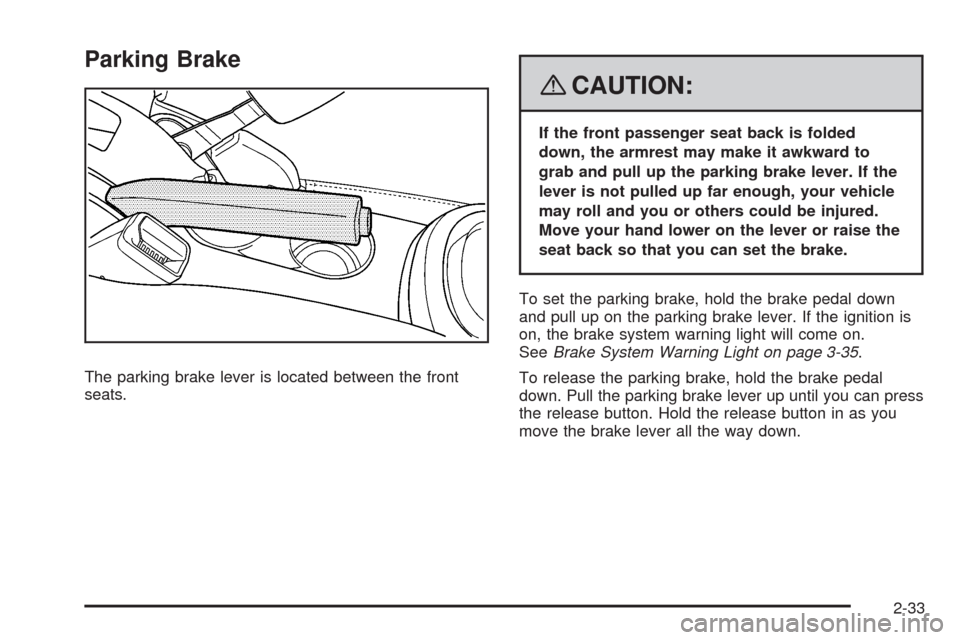
Parking Brake
The parking brake lever is located between the front
seats.
{CAUTION:
If the front passenger seat back is folded
down, the armrest may make it awkward to
grab and pull up the parking brake lever. If the
lever is not pulled up far enough, your vehicle
may roll and you or others could be injured.
Move your hand lower on the lever or raise the
seat back so that you can set the brake.
To set the parking brake, hold the brake pedal down
and pull up on the parking brake lever. If the ignition is
on, the brake system warning light will come on.
SeeBrake System Warning Light on page 3-35.
To release the parking brake, hold the brake pedal
down. Pull the parking brake lever up until you can press
the release button. Hold the release button in as you
move the brake lever all the way down.
2-33
Page 112 of 430
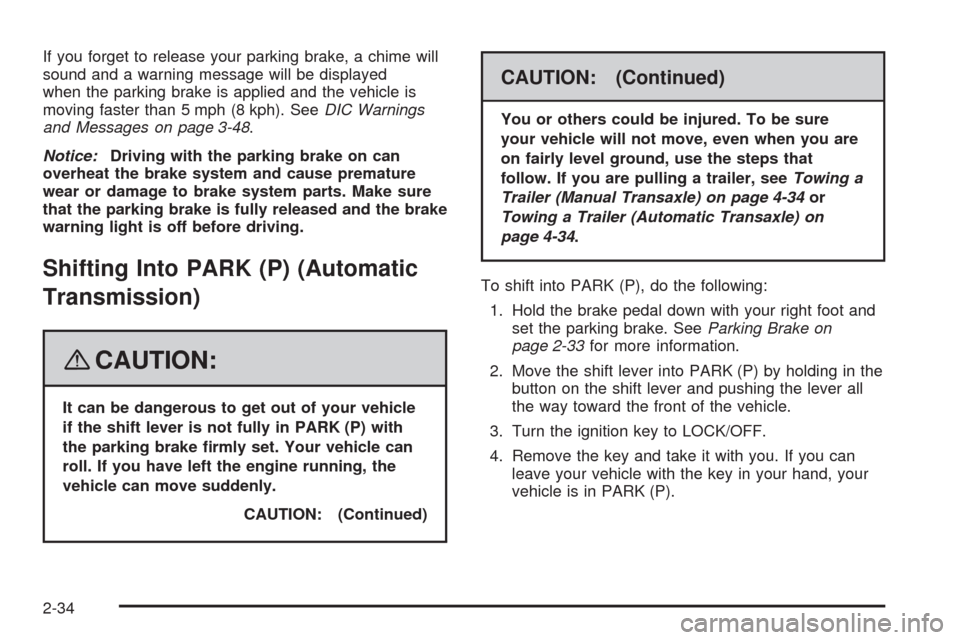
If you forget to release your parking brake, a chime will
sound and a warning message will be displayed
when the parking brake is applied and the vehicle is
moving faster than 5 mph (8 kph). SeeDIC Warnings
and Messages on page 3-48.
Notice:Driving with the parking brake on can
overheat the brake system and cause premature
wear or damage to brake system parts. Make sure
that the parking brake is fully released and the brake
warning light is off before driving.
Shifting Into PARK (P) (Automatic
Transmission)
{CAUTION:
It can be dangerous to get out of your vehicle
if the shift lever is not fully in PARK (P) with
the parking brake �rmly set. Your vehicle can
roll. If you have left the engine running, the
vehicle can move suddenly.
CAUTION: (Continued)
CAUTION: (Continued)
You or others could be injured. To be sure
your vehicle will not move, even when you are
on fairly level ground, use the steps that
follow. If you are pulling a trailer, seeTowing a
Trailer (Manual Transaxle) on page 4-34or
Towing a Trailer (Automatic Transaxle) on
page 4-34.
To shift into PARK (P), do the following:
1. Hold the brake pedal down with your right foot and
set the parking brake. SeeParking Brake on
page 2-33for more information.
2. Move the shift lever into PARK (P) by holding in the
button on the shift lever and pushing the lever all
the way toward the front of the vehicle.
3. Turn the ignition key to LOCK/OFF.
4. Remove the key and take it with you. If you can
leave your vehicle with the key in your hand, your
vehicle is in PARK (P).
2-34
Page 113 of 430
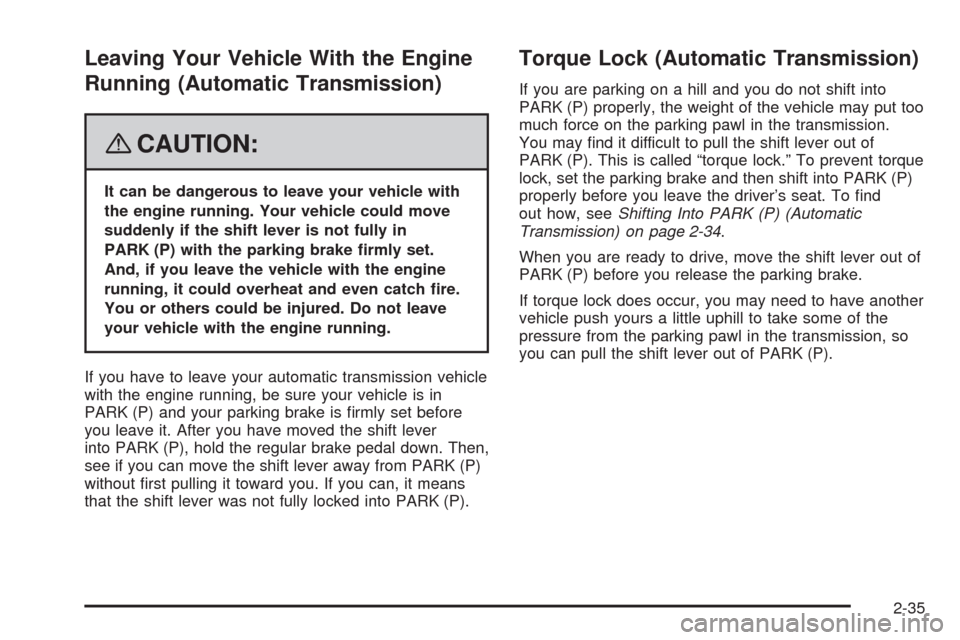
Leaving Your Vehicle With the Engine
Running (Automatic Transmission)
{CAUTION:
It can be dangerous to leave your vehicle with
the engine running. Your vehicle could move
suddenly if the shift lever is not fully in
PARK (P) with the parking brake �rmly set.
And, if you leave the vehicle with the engine
running, it could overheat and even catch �re.
You or others could be injured. Do not leave
your vehicle with the engine running.
If you have to leave your automatic transmission vehicle
with the engine running, be sure your vehicle is in
PARK (P) and your parking brake is �rmly set before
you leave it. After you have moved the shift lever
into PARK (P), hold the regular brake pedal down. Then,
see if you can move the shift lever away from PARK (P)
without �rst pulling it toward you. If you can, it means
that the shift lever was not fully locked into PARK (P).
Torque Lock (Automatic Transmission)
If you are parking on a hill and you do not shift into
PARK (P) properly, the weight of the vehicle may put too
much force on the parking pawl in the transmission.
You may �nd it difficult to pull the shift lever out of
PARK (P). This is called “torque lock.” To prevent torque
lock, set the parking brake and then shift into PARK (P)
properly before you leave the driver’s seat. To �nd
out how, seeShifting Into PARK (P) (Automatic
Transmission) on page 2-34.
When you are ready to drive, move the shift lever out of
PARK (P) before you release the parking brake.
If torque lock does occur, you may need to have another
vehicle push yours a little uphill to take some of the
pressure from the parking pawl in the transmission, so
you can pull the shift lever out of PARK (P).
2-35
Page 114 of 430
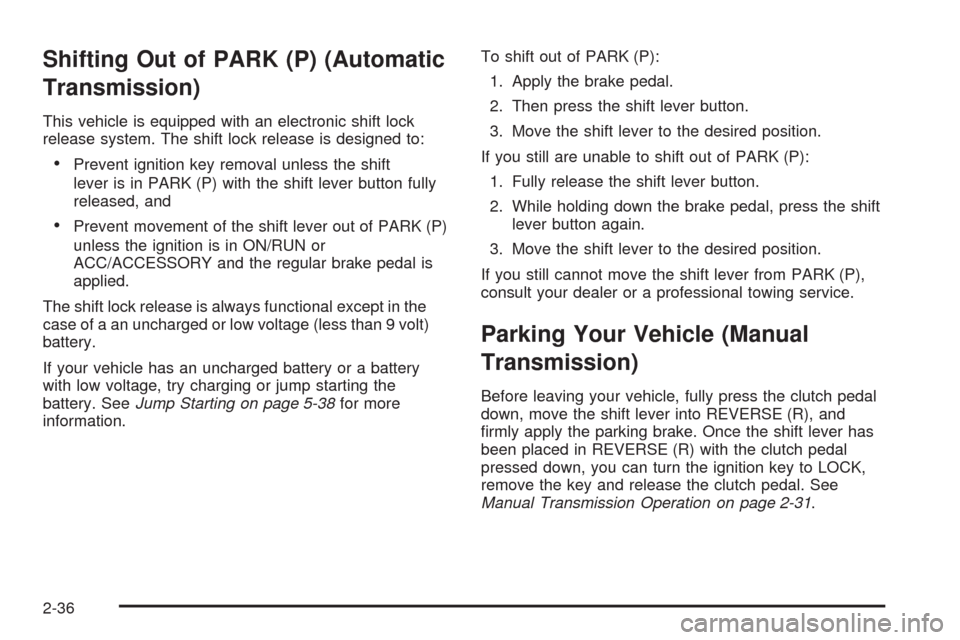
Shifting Out of PARK (P) (Automatic
Transmission)
This vehicle is equipped with an electronic shift lock
release system. The shift lock release is designed to:
Prevent ignition key removal unless the shift
lever is in PARK (P) with the shift lever button fully
released, and
Prevent movement of the shift lever out of PARK (P)
unless the ignition is in ON/RUN or
ACC/ACCESSORY and the regular brake pedal is
applied.
The shift lock release is always functional except in the
case of a an uncharged or low voltage (less than 9 volt)
battery.
If your vehicle has an uncharged battery or a battery
with low voltage, try charging or jump starting the
battery. SeeJump Starting on page 5-38for more
information.To shift out of PARK (P):
1. Apply the brake pedal.
2. Then press the shift lever button.
3. Move the shift lever to the desired position.
If you still are unable to shift out of PARK (P):
1. Fully release the shift lever button.
2. While holding down the brake pedal, press the shift
lever button again.
3. Move the shift lever to the desired position.
If you still cannot move the shift lever from PARK (P),
consult your dealer or a professional towing service.
Parking Your Vehicle (Manual
Transmission)
Before leaving your vehicle, fully press the clutch pedal
down, move the shift lever into REVERSE (R), and
�rmly apply the parking brake. Once the shift lever has
been placed in REVERSE (R) with the clutch pedal
pressed down, you can turn the ignition key to LOCK,
remove the key and release the clutch pedal. See
Manual Transmission Operation on page 2-31.
2-36
Page 115 of 430
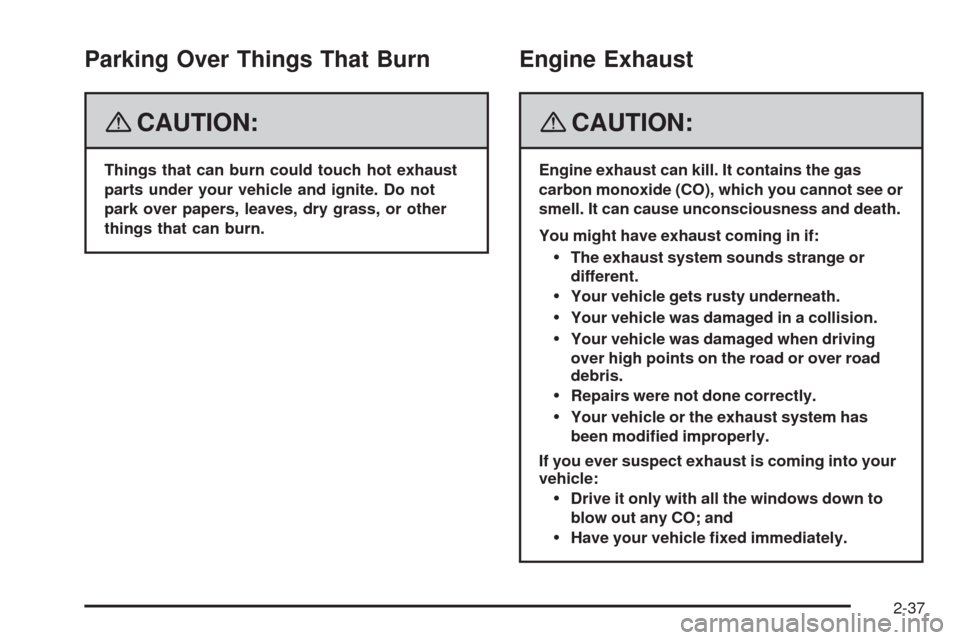
Parking Over Things That Burn
{CAUTION:
Things that can burn could touch hot exhaust
parts under your vehicle and ignite. Do not
park over papers, leaves, dry grass, or other
things that can burn.
Engine Exhaust
{CAUTION:
Engine exhaust can kill. It contains the gas
carbon monoxide (CO), which you cannot see or
smell. It can cause unconsciousness and death.
You might have exhaust coming in if:
The exhaust system sounds strange or
different.
Your vehicle gets rusty underneath.
Your vehicle was damaged in a collision.
Your vehicle was damaged when driving
over high points on the road or over road
debris.
Repairs were not done correctly.
Your vehicle or the exhaust system has
been modi�ed improperly.
If you ever suspect exhaust is coming into your
vehicle:
Drive it only with all the windows down to
blow out any CO; and
Have your vehicle �xed immediately.
2-37
Page 116 of 430
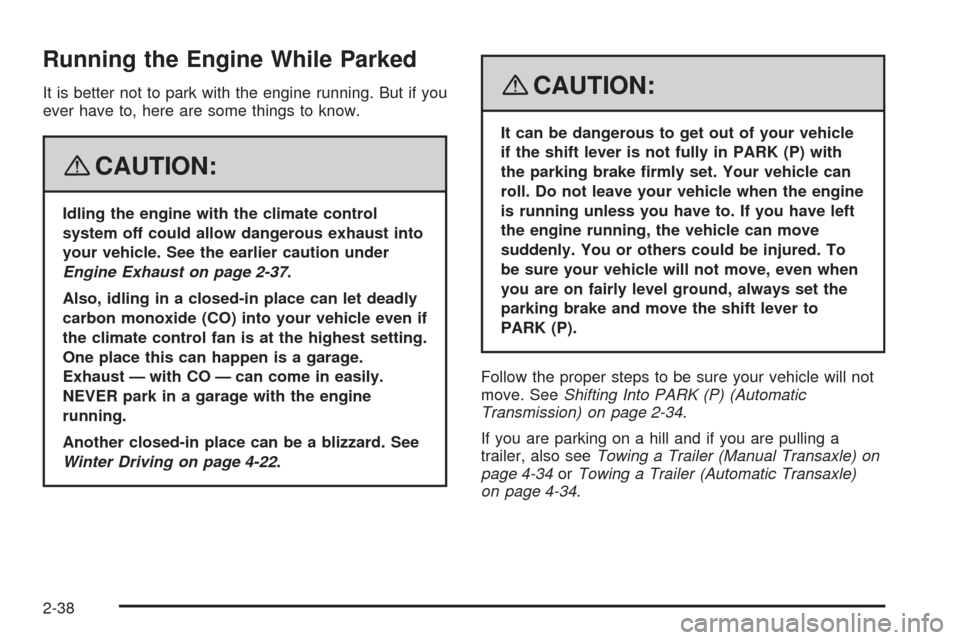
Running the Engine While Parked
It is better not to park with the engine running. But if you
ever have to, here are some things to know.
{CAUTION:
Idling the engine with the climate control
system off could allow dangerous exhaust into
your vehicle. See the earlier caution under
Engine Exhaust on page 2-37.
Also, idling in a closed-in place can let deadly
carbon monoxide (CO) into your vehicle even if
the climate control fan is at the highest setting.
One place this can happen is a garage.
Exhaust — with CO — can come in easily.
NEVER park in a garage with the engine
running.
Another closed-in place can be a blizzard. See
Winter Driving on page 4-22.
{CAUTION:
It can be dangerous to get out of your vehicle
if the shift lever is not fully in PARK (P) with
the parking brake �rmly set. Your vehicle can
roll. Do not leave your vehicle when the engine
is running unless you have to. If you have left
the engine running, the vehicle can move
suddenly. You or others could be injured. To
be sure your vehicle will not move, even when
you are on fairly level ground, always set the
parking brake and move the shift lever to
PARK (P).
Follow the proper steps to be sure your vehicle will not
move. SeeShifting Into PARK (P) (Automatic
Transmission) on page 2-34.
If you are parking on a hill and if you are pulling a
trailer, also seeTowing a Trailer (Manual Transaxle) on
page 4-34orTowing a Trailer (Automatic Transaxle)
on page 4-34.
2-38
Page 117 of 430
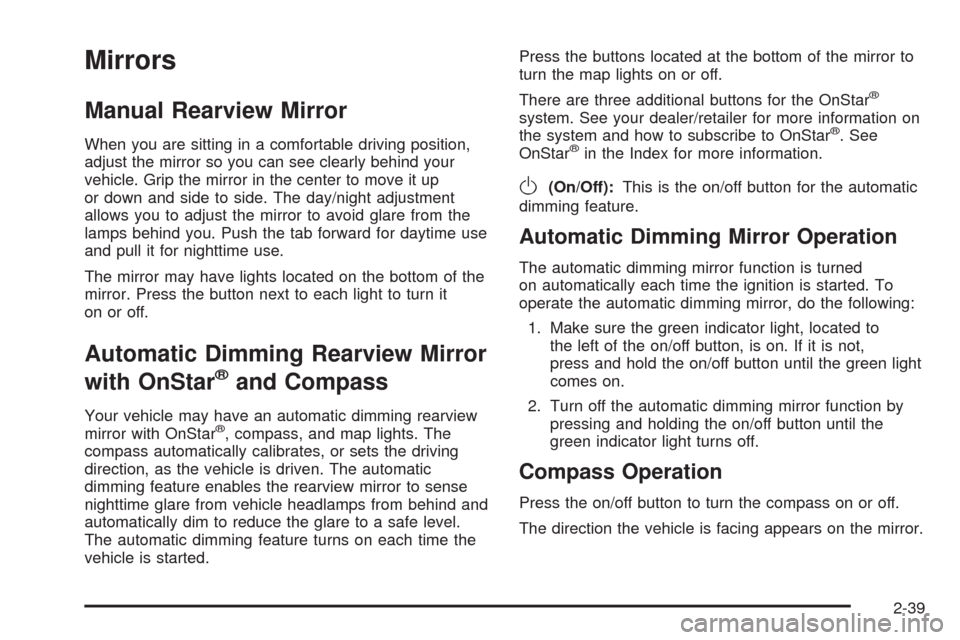
Mirrors
Manual Rearview Mirror
When you are sitting in a comfortable driving position,
adjust the mirror so you can see clearly behind your
vehicle. Grip the mirror in the center to move it up
or down and side to side. The day/night adjustment
allows you to adjust the mirror to avoid glare from the
lamps behind you. Push the tab forward for daytime use
and pull it for nighttime use.
The mirror may have lights located on the bottom of the
mirror. Press the button next to each light to turn it
on or off.
Automatic Dimming Rearview Mirror
with OnStar
®and Compass
Your vehicle may have an automatic dimming rearview
mirror with OnStar®, compass, and map lights. The
compass automatically calibrates, or sets the driving
direction, as the vehicle is driven. The automatic
dimming feature enables the rearview mirror to sense
nighttime glare from vehicle headlamps from behind and
automatically dim to reduce the glare to a safe level.
The automatic dimming feature turns on each time the
vehicle is started.Press the buttons located at the bottom of the mirror to
turn the map lights on or off.
There are three additional buttons for the OnStar
®
system. See your dealer/retailer for more information on
the system and how to subscribe to OnStar®. See
OnStar®in the Index for more information.
O(On/Off):This is the on/off button for the automatic
dimming feature.
Automatic Dimming Mirror Operation
The automatic dimming mirror function is turned
on automatically each time the ignition is started. To
operate the automatic dimming mirror, do the following:
1. Make sure the green indicator light, located to
the left of the on/off button, is on. If it is not,
press and hold the on/off button until the green light
comes on.
2. Turn off the automatic dimming mirror function by
pressing and holding the on/off button until the
green indicator light turns off.
Compass Operation
Press the on/off button to turn the compass on or off.
The direction the vehicle is facing appears on the mirror.
2-39
Page 118 of 430
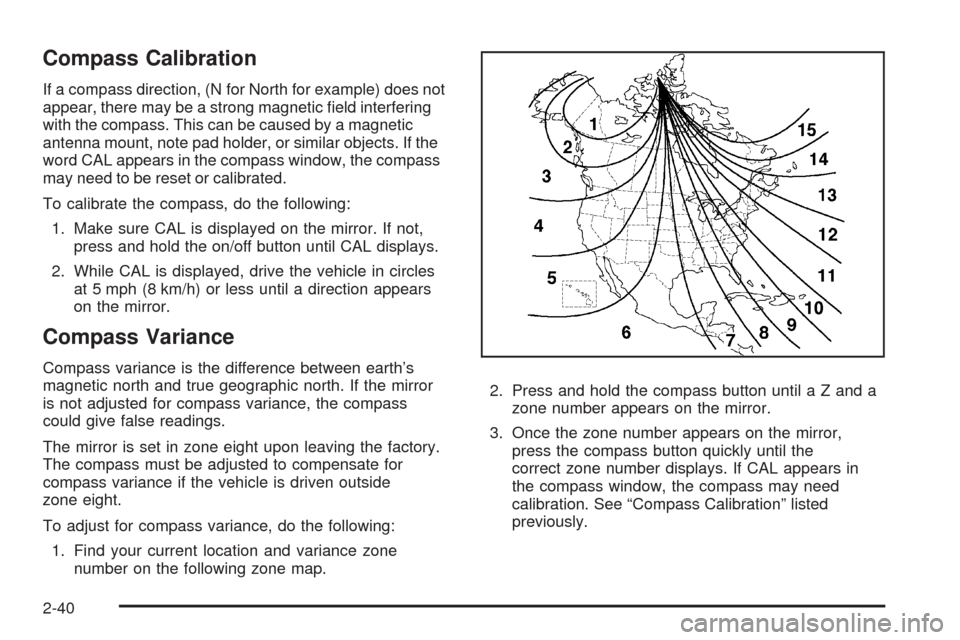
Compass Calibration
If a compass direction, (N for North for example) does not
appear, there may be a strong magnetic �eld interfering
with the compass. This can be caused by a magnetic
antenna mount, note pad holder, or similar objects. If the
word CAL appears in the compass window, the compass
may need to be reset or calibrated.
To calibrate the compass, do the following:
1. Make sure CAL is displayed on the mirror. If not,
press and hold the on/off button until CAL displays.
2. While CAL is displayed, drive the vehicle in circles
at 5 mph (8 km/h) or less until a direction appears
on the mirror.
Compass Variance
Compass variance is the difference between earth’s
magnetic north and true geographic north. If the mirror
is not adjusted for compass variance, the compass
could give false readings.
The mirror is set in zone eight upon leaving the factory.
The compass must be adjusted to compensate for
compass variance if the vehicle is driven outside
zone eight.
To adjust for compass variance, do the following:
1. Find your current location and variance zone
number on the following zone map.2. Press and hold the compass button until a Z and a
zone number appears on the mirror.
3. Once the zone number appears on the mirror,
press the compass button quickly until the
correct zone number displays. If CAL appears in
the compass window, the compass may need
calibration. See “Compass Calibration” listed
previously.
2-40
Page 119 of 430
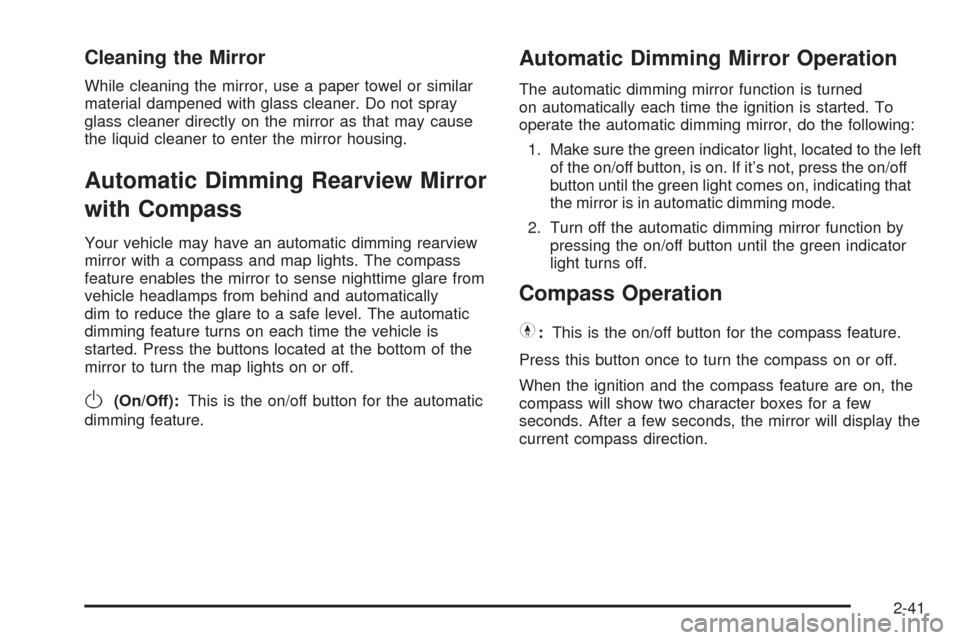
Cleaning the Mirror
While cleaning the mirror, use a paper towel or similar
material dampened with glass cleaner. Do not spray
glass cleaner directly on the mirror as that may cause
the liquid cleaner to enter the mirror housing.
Automatic Dimming Rearview Mirror
with Compass
Your vehicle may have an automatic dimming rearview
mirror with a compass and map lights. The compass
feature enables the mirror to sense nighttime glare from
vehicle headlamps from behind and automatically
dim to reduce the glare to a safe level. The automatic
dimming feature turns on each time the vehicle is
started. Press the buttons located at the bottom of the
mirror to turn the map lights on or off.
O(On/Off):This is the on/off button for the automatic
dimming feature.
Automatic Dimming Mirror Operation
The automatic dimming mirror function is turned
on automatically each time the ignition is started. To
operate the automatic dimming mirror, do the following:
1. Make sure the green indicator light, located to the left
of the on/off button, is on. If it’s not, press the on/off
button until the green light comes on, indicating that
the mirror is in automatic dimming mode.
2. Turn off the automatic dimming mirror function by
pressing the on/off button until the green indicator
light turns off.
Compass Operation
Y
:This is the on/off button for the compass feature.
Press this button once to turn the compass on or off.
When the ignition and the compass feature are on, the
compass will show two character boxes for a few
seconds. After a few seconds, the mirror will display the
current compass direction.
2-41
Page 120 of 430
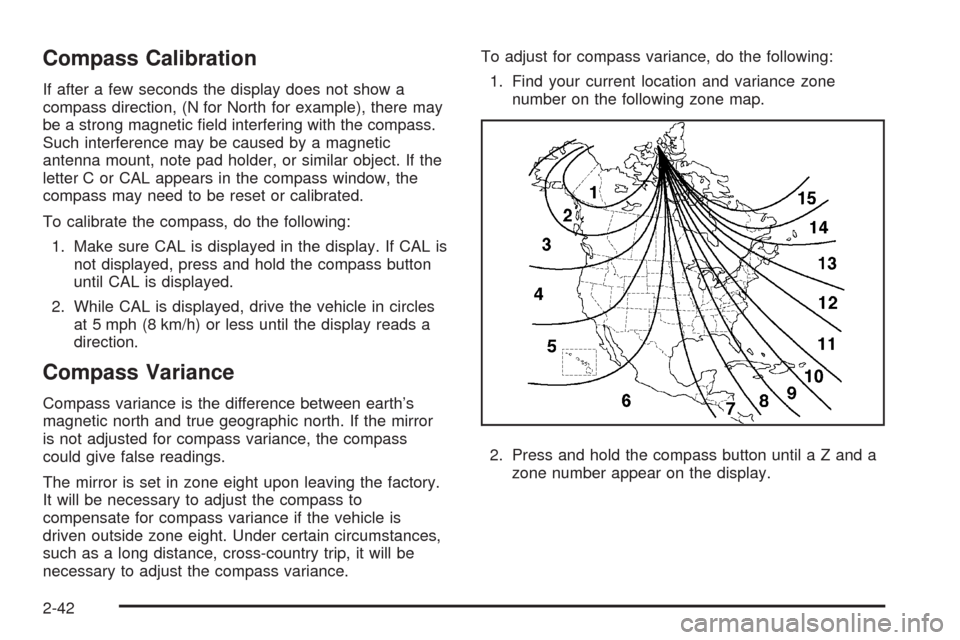
Compass Calibration
If after a few seconds the display does not show a
compass direction, (N for North for example), there may
be a strong magnetic �eld interfering with the compass.
Such interference may be caused by a magnetic
antenna mount, note pad holder, or similar object. If the
letter C or CAL appears in the compass window, the
compass may need to be reset or calibrated.
To calibrate the compass, do the following:
1. Make sure CAL is displayed in the display. If CAL is
not displayed, press and hold the compass button
until CAL is displayed.
2. While CAL is displayed, drive the vehicle in circles
at 5 mph (8 km/h) or less until the display reads a
direction.
Compass Variance
Compass variance is the difference between earth’s
magnetic north and true geographic north. If the mirror
is not adjusted for compass variance, the compass
could give false readings.
The mirror is set in zone eight upon leaving the factory.
It will be necessary to adjust the compass to
compensate for compass variance if the vehicle is
driven outside zone eight. Under certain circumstances,
such as a long distance, cross-country trip, it will be
necessary to adjust the compass variance.To adjust for compass variance, do the following:
1. Find your current location and variance zone
number on the following zone map.
2. Press and hold the compass button until a Z and a
zone number appear on the display.
2-42